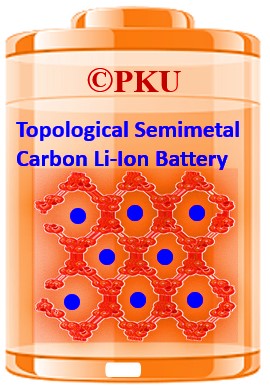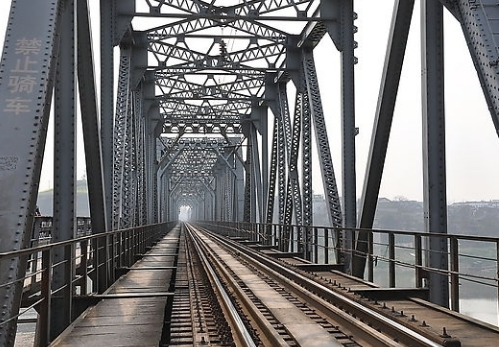
Topological semi-metal carbon lithium battery schematic
The PNAS of the National Academy of Sciences recently published the research paper of Prof. Sun Qiang of the Institute of Applied Physics and Technology, Peking University’s Institute of Applied Materials and Science and Engineering, “All Carbon Based Porous Topological Semimetal for Li-ion Battery Anode Material. ", reported their latest achievements in the field of lithium-ion battery anode materials.
Lithium-ion batteries play an important role in people's daily lives because of their high power density and mature commercial applications. However, with the development of science and technology, especially the rise of electric vehicles, the existing lithium-ion batteries are increasingly difficult to meet people's requirements for energy storage. Lithium-ion batteries are mainly composed of a positive electrode, a negative electrode, and an electrolyte. The use of a negative electrode as a main part of the lithium storage of the battery is one of the key factors in improving the overall performance of the lithium-ion battery. Therefore, it has also been a research hotspot. Graphite carbon material is a widely used negative electrode material for commercial lithium-ion batteries due to its good stability and low cost, but its actual capacity is only 290-360 mAh/g. Although this capacity can basically meet the requirements of existing electronic products for battery performance, there is still a big gap between capacity and rate performance in the field of electric vehicles that have higher requirements for battery energy density, override, and safety. On the other hand, the capacity of graphitic carbon material has approached the theoretical capacity limit of 372 mAh/g. To further increase the capacity of the battery, it is necessary to find a new lithium-ion battery anode material system. Porous carbon has a large specific surface area and many sites for lithium ion adsorption has always been a hot spot for people to find high specific capacity cathode materials, but porous carbon storage also has its inherent disadvantages: (1) porosity will form a large number of materials Disordered defects reduce the conductivity of the material, which in turn affects the battery's rate performance. (2) Lithium ions undergo a large number of irreversible reactions at the interface between the pores and the electrolyte, resulting in irreversible capacity loss, resulting in low Coulombic efficiency. The general Coulombic efficiency of porous carbon materials is less than 50%. For a full battery, the total amount of lithium ions that the positive electrode can carry is certain, and a large irreversible capacity loss is a fatal drawback. (3) The disordered pores in the conventional porous carbon are not conducive to the diffusion of ions and the improvement of the battery rate performance. In order to solve the above problems, it is ideal to find a three-dimensional carbon material that has both ordered nanochannels and high conductivity, and topological half-metal carbon materials provide this possibility.
Topology electronics is the frontier of physics research in recent years. The 2016 Nobel Prize in Physics also awarded three physicists who made pioneering contributions in this direction. The topological half-metal material has a linear band-dispersion relationship at the Fermi surface. The effective mass of electrons is zero and the electron mobility is extremely high. Moreover, this linear energy-band dispersion relationship is determined by the overall structure of the material and is protected by symmetry. This provides the possibility of finding a three-dimensional porous carbon negative electrode material having high conductivity. Based on this, Sun Qiang's research group conducted a systematic study on the possibility of the three-dimensional topological semi-metal carbon bco-C16 that was recently predicted by the theory as a negative electrode material for lithium-ion batteries. Based on first-principles calculations, it is shown that lithium ions can be reversibly deintercalated in bco-C16 with a theoretical specific capacity of 558 mAh/g (Li-C4), which is much higher than that of commercial graphite anode materials (Li-C6). ). Since bco-C16 has one-dimensional nanochannels, the diffusion of lithium ions presents a distinct one-dimensional characteristic. With the insertion of lithium ions, the diffusion energy barrier is reduced from 0.53 eV to 0.019 eV, and this one-dimensional lithium ion diffusion Features will still be maintained under very large tensile and compressive deformations. The calculated average open-circuit voltage is 0.23 V, and the volume change of bco-C16 is comparable to that of graphite during the lithium removal process. The above results show that the topological half-metal porous carbon bco-C16 anode has higher specific capacity, higher rate performance, lower electrode potential, and better cycle stability than graphite carbon, and thus has a good application prospect. .
Topological electronic states and lithium-ion batteries are two hot spots in today's science and technology research. The study used topological semi-metallic carbon materials as the negative electrode of lithium batteries. It is natural to establish a bridge between these two fields. This not only pointed out a new direction for designing high-performance lithium-ion batteries, but also broadened the topological electronics. State of application of research.
The first and second authors of the paper were Dr. Liu Junyi and Wang Shuo, respectively, and the author was Professor Sun Qiang. The study was funded by the National New Energy Auto Project and the National Natural Science Foundation of China.
Railway Bridge is a bridge designed and built for trains to travel
across river or road. Steel structured railway bridge features long span, light
weight, easy assembly, and therefore is priority for project with which has
high requirements. In the past 10 years, Zhongda has manufactured many bridge
projects and most of them are government projects, and has wide experiences on
manufacturing of steel structured bridges. 
Railway Bridge
Railway Bridge,Railway Steel Bridge,Prefabricated Railway Bridge,Steel Structure Truss Railway Bridge
Zhongda Steel Structure , https://www.zhongdametal.com
